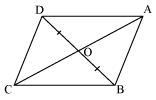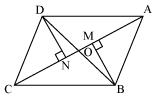
In Fig. 9.25, diagonals AC and BD of quadrilateral ABCD intersect at O such that OB = OD.
If AB = CD, then show that:
In the given figure, diagonals AC and BD of quadrilateral ABCD intersect at O such that OB = OD. If AB = CD, then show that:
(i) ar (DOC) = ar (AOB)
(ii) ar (DCB) = ar (ACB)
(iii) DA || CB or ABCD is a parallelogram.
[Hint: From D and B, draw perpendiculars to AC.]

Answer

Let us draw DN ⊥ AC and BM ⊥ AC.
(i) In ΔDON and ΔBOM,
∠ DNO = ∠ BMO (By construction)
∠ DON = ∠ BOM (Vertically opposite angles)
OD = OB (Given)
By AAS congruence rule,
ΔDON ≅ ΔBOM
∴ DN = BM ... (1)
We know that congruent triangles have equal areas.
∴ Area (ΔDON) = Area (ΔBOM) ... (2)
In ΔDNC and ΔBMA,
∠ DNC = ∠ BMA (By construction)
CD = AB (Given)
DN = BM [Using equation (1)]
∴ ΔDNC ≅ ΔBMA (RHS congruence rule)
⇒ Area (ΔDNC) = Area (ΔBMA) ... (3)
On adding equations (2) and (3), we obtain
Area (ΔDON) + Area (ΔDNC) = Area (ΔBOM) + Area (ΔBMA)
Therefore, Area (ΔDOC) = Area (ΔAOB)
(ii) We obtained,
Area (ΔDOC) = Area (ΔAOB)
⇒ Area (ΔDOC) + Area (ΔOCB) = Area (ΔAOB) + Area (ΔOCB)
(Adding Area (ΔOCB) to both sides)
⇒ Area (ΔDCB) = Area (ΔACB)
(iii) We obtained,
Area (ΔDCB) = Area (ΔACB)
If two triangles have the same base and equal areas, then these will lie between the same parallels.
∴ DA || CB ... (4)
In ΔDOA and ΔBOC,
∠ DOA = ∠ BOC (Vertically opposite angles)
OD = OB (Given)
∠ ODA = ∠ OBC (Alternate opposite angles)
By ASA congruence rule,
ΔDOA ≅ ΔBOC
∴ DA = BC ... (5)
In quadrilateral ABCD, one pair of opposite sides is equal and parallel (AD = BC)
Therefore, ABCD is a parallelogram.